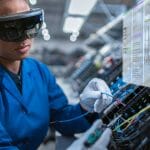Can thermal cameras be used to detect a virus or an infection? The quick answer to this question is no, but thermal imaging cameras can be used to detect Elevated Body Temperature. FLIR thermal cameras have a long history of being used in public spaces—such as airports, train terminals, businesses, factories, and concerts—as an effective tool to measure skin surface temperature and identify individuals with Elevated Body Temperature (EBT).
In light of the global outbreak of the coronavirus (COVID-19), which is now officially a pandemic, society is deeply concerned about the spread of infection and seeking tools to help slow and ultimately stop the spread of the virus. Although no thermal cameras can detect or diagnose the coronavirus, FLIR cameras can be used as an adjunct to other body temperature screening tools for detecting elevated skin temperature in high-traffic public places through quick individual screening.
If the temperature of the skin in key areas (especially the corner of the eye and forehead) is above average temperature, then the individual may be selected for additional screening. Identifying individuals with EBT, who should then be further screened with virus-specific diagnostic tests, can help reduce or dramatically slow the spread of viruses and infections.

The thermal camera must be able to image the inner corner (tearduct) of the eye when screening for EBT. Have subjects remove glasses or any other eye obstructions before screening.
Using thermal cameras, officials can be more discrete, efficient, and effective in identifying individuals that need further screening with virus-specific tests. A variety of institutions, including transportation agencies, businesses, factories, and first responders are using thermal screening as an EBT detection method and as part of employee health and screening (EH&S).
Airports in particular are actively employing FLIR thermal cameras as part of their screening measures for passengers and flight crews. The screening procedures implemented at airports and in other public places are just the first step when it comes to detecting a possible infection: it’s a quick way to screen for anyone who might be sick, and must always be followed up with further screening before authorities decide to quarantine a person.

When screening for EBT with a FLIR thermal camera, it’s important to screen one person at a time, standing no more than 1-2 meters away from the camera.
What FLIR cameras are used for thermal screening?
While governments outside the United States may choose from many different cameras, FLIR has a 510(k) filing (K033967) with the US Food and Drug Administration (FDA) for select camera models for use as an adjunct to other body temperature screening tools to detect differences in skin surface temperatures. These cameras include the FLIR Exx-Series, FLIR T-Series, FLIR A320, and Extech IR200.
For more information about ordering FLIR cameras for temperature screening purposes in the United States, please call +1 866.477.3687.







